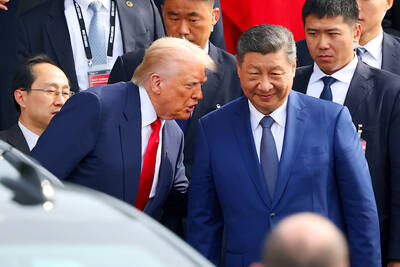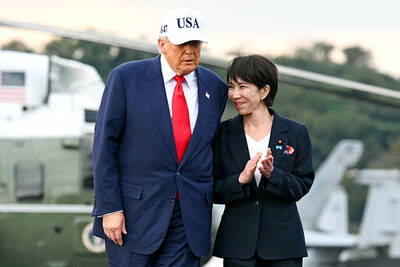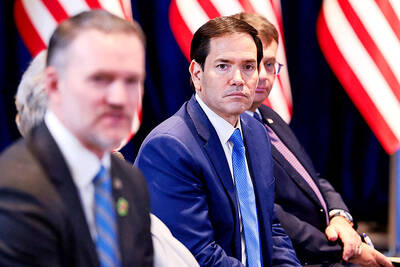The global economic outlook is increasingly grim with the US mired in a recession from a housing meltdown whose effects are still spreading, the IMF said on Wednesday.
Global expansion is set to slow to 3.7 percent this year amid an unfolding crisis that began in the US, the IMF said in its semiannual World Economic Outlook (WEO) report.
The growth estimate is a half point lower than its January WEO update.
The US economy, the world’s biggest, is likely in a “mild recession” and will stagnate through much of next year as housing prices slide further and credit conditions remain difficult.
For the world economy, there is a 25 percent chance of dropping below three percent growth in this year and next year, which according to the IMF would be the equivalent of a global recession.
“Moreover, growth is projected to remain broadly unchanged in 2009,” with growth in the advanced economies likely to fall “well below potential.”
The US, the epicenter of the turmoil, is poised to grow a paltry 0.5 percent next year, the IMF said, despite a multibillion-dollar government stimulus package.
US growth for next year will improve to 0.6 percent, a “modest” recovery expected as financial institutions clean up their balance sheets.
The risks to global growth remain “tilted to the downside,” the IMF warned in the report, a key plank of its spring meetings with the World Bank in Washington tomorrow and Sunday.
The IMF underscored the potential for “deep losses” on structured credit related to the US subprime mortgage market and other sectors.
Those losses could “cause the current credit squeeze to mutate into a full-blown credit crunch,” said the 185-nation institution, whose mission is to promote global financial stability.
A top US official said the IMF was too downbeat in its outlook.
“We remain positive about the long-term resilience of the global economy, as well as the long-term resilience of the US economy, and we believe that the IMF’s latest WEO projections are unduly pessimistic,” Treasury Under Secretary for International Affairs David McCormick told journalists.
McCormick did not offer any more specific growth numbers but said the US believes the IMF projections are “significantly below consensus.”
He also said the administration hopes a faster recovery this year and a “steeper growth curve” next year.
In its report, the IMF said that growth in western Europe is projected to slow “well below” potential due to financial strains, trade spillovers and housing downturns in some countries.
Growth in the 15-nation eurozone is set to decelerate to 1.4 percent this year and 1.2 percent next year, down 0.2 percent and 0.7 percent respectively from the January update.
Japan, the world’s second-largest economy, is poised to slow to pace of 1.4 percent this year with little improvement at 1.5 percent next year.
By contrast, emerging and developing countries have proven more resilient to the distress because they are underpinned by their increasing integration into the global economy and a commodity price boom, the IMF said.
Their combined growth will decelerate to a still-robust 6.7 percent expansion this year, off 0.2 percentage points from the prior forecast, and slip to 6.6 percent next year.
China and India, the new engines of global growth, will also feel the slowdown, the IMF said.
China will continue to lead growth, expanding at 9.3 percent this year and 9.5 percent next year, down 0.7 point and 0.5 point respectively. India is poised for a 7.9 percent expansion this year, down 0.5 point, and 8.0 percent next year, off 0.2 point.
The US Federal Reserve’s recent steep interest-rate cuts and credit easing have been justified amid rising dampeners on economic growth, the IMF said, while the European Central Bank, despite rising inflationary pressures in the eurozone, “can afford some easing of the policy stance.”
The IMF recommended that the Japanese central bank keep its already low interest rate, at 0.5 percent, on hold, saying there would be “some limited scope” for a reduction if growth prospects sharply deteriorated.
The IMF said policymakers should seek to rebuild confidence in the financial system, strengthen the soundness of institutions and ease liquidity stress.

UKRAINE, NVIDIA: The US leader said the subject of Russia’s war had come up ‘very strongly,’ while Jenson Huang was hoping that the conversation was good Chinese President Xi Jinping (習近平) and US President Donald Trump had differing takes following their meeting in Busan, South Korea, yesterday. Xi said that the two sides should complete follow-up work as soon as possible to deliver tangible results that would provide “peace of mind” to China, the US and the rest of the world, while Trump hailed the “great success” of the talks. The two discussed trade, including a deal to reduce tariffs slapped on China for its role in the fentanyl trade, as well as cooperation in ending the war in Ukraine, among other issues, but they did not mention

Japanese Prime Minister Sanae Takaichi yesterday lavished US President Donald Trump with praise and vows of a “golden age” of ties on his visit to Tokyo, before inking a deal with Washington aimed at securing critical minerals. Takaichi — Japan’s first female prime minister — pulled out all the stops for Trump in her opening test on the international stage and even announced that she would nominate him for a Nobel Peace Prize, the White House said. Trump has become increasingly focused on the Nobel since his return to power in January and claims to have ended several conflicts around the world,

GLOBAL PROJECT: Underseas cables ‘are the nervous system of democratic connectivity,’ which is under stress, Member of the European Parliament Rihards Kols said The government yesterday launched an initiative to promote global cooperation on improved security of undersea cables, following reported disruptions of such cables near Taiwan and around the world. The Management Initiative on International Undersea Cables aims to “bring together stakeholders, align standards, promote best practices and turn shared concerns into beneficial cooperation,” Minister of Foreign Affairs Lin Chia-lung (林佳龍) said at a seminar in Taipei. The project would be known as “RISK,” an acronym for risk mitigation, information sharing, systemic reform and knowledge building, he said at the seminar, titled “Taiwan-Europe Subsea Cable Security Cooperation Forum.” Taiwan sits at a vital junction on

LONG-HELD POSITION: Washington has repeatedly and clearly reiterated its support for Taiwan and its long-term policy, the Ministry of Foreign Affairs said US Secretary of State Marco Rubio yesterday said that Taiwan should not be concerned about being used as a bargaining chip in the ongoing US-China trade talks. “I don’t think you’re going to see some trade deal where, if what people are worried about is, we’re going to get some trade deal or we’re going to get favorable treatment on trade in exchange for walking away from Taiwan,” Rubio told reporters aboard his airplane traveling between Israel and Qatar en route to Asia. “No one is contemplating that,” Reuters quoted Rubio as saying. A US Treasury spokesman yesterday told reporters